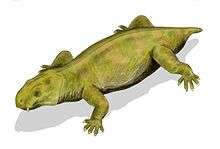1845 in paleontology
Paleontology or palaeontology is the study of prehistoric life forms on Earth through the examination of plant and animal fossils.[1] This includes the study of body fossils, tracks (ichnites), burrows, cast-off parts, fossilised feces (coprolites), palynomorphs and chemical residues. Because humans have encountered fossils for millennia, paleontology has a long history both before and after becoming formalized as a science. This article records significant discoveries and events related to paleontology that occurred or were published in the year 1845.
| |||
|---|---|---|---|
Plesiosaurs
New taxa
|
| |||||||||||||
Synapsids
Non-mammalian
| Name | Status | Authors | Age | Location | Notes | Images |
|---|---|---|---|---|---|---|
|
Valid |
Owen |
255 Million years ago. | ||||
Mammals
| Name | Authors | Age | Location | Notes | Images |
|---|---|---|---|---|---|
| Coryphodon | Owen | 52 Million years ago. |
|
An Hippo-like mammal. |
gollark: It might not be a good line, but it believes in itself.
gollark: * A_o and B_o 0.
gollark: Ah, so if I make A_o and B_o then it implodes?
gollark: Oh, it works.
gollark: What if I make the line vertical?
References
- Gini-Newman, Garfield; Graham, Elizabeth (2001). Echoes from the past: world history to the 16th century. Toronto: McGraw-Hill Ryerson Ltd. ISBN 9780070887398. OCLC 46769716.
This article is issued from Wikipedia. The text is licensed under Creative Commons - Attribution - Sharealike. Additional terms may apply for the media files.

.jpg)